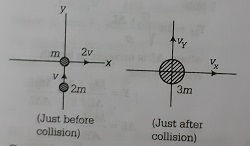Answer:
Option C
Explanation:
Central Idea: Conservation of linear momentum can be applied but energy is not conserved.Consider the movement of two particles as shown below.

Conserving linear momentum in x-direction
(pi)x=(pf)x
or 2mv=(2m+m)vx
vx=$\frac{2}{3}v$
Considering linear momentum in y-direction
(pi)y=(pf)y
or 2mv=(2m+m)vy
Vy=$\frac{2}{3}v$
Initial kinetic energy of two particles sysytem is
$E_{i}=\frac{1}{2}m(2v^{2})+\frac{1}{2}(2m)(v)^{2}$
$=\frac{1}{2}4mv^{2}+\frac{1}{2}2mv^{2}$
$3mv^{2}$
Final energy of the combined two particles system is
$E_{f}=\frac{1}{2}(3m)(v_x^2+v_y^2)$
$=\frac{1}{2}(3m)\left[\frac{4v^{2}}{9}+\frac{4v^{2}}{9}\right]$
$=\frac{3m}{2}\left[\frac{8v^{2}}{9}\right]=\frac{4mv^{2}}{3}$
loss in the energy
$\Delta E=E_{i}-E_{f}$
$mv^{2}\left[3-\frac{4}{3}\right]=\frac{5}{3}mv^{2}$
Percentage loss in the energy during the collision
$\frac{\Delta E}{Ei}\times 100=\frac{\frac{5}{3}mv^{2}}{3mv^{2}}\times 100=\frac{5}{9}\times 100$
$\simeq 56%$